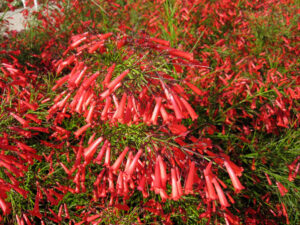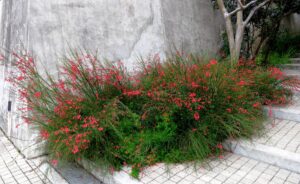- South Texas Students Meet Accordion Music Icons Los Tigres Del Norte In Edinburg Thanks To Khs America/Hohner Alianza Académica Initiative
- Fragile Planet Offers a Nighttime Wildlife Experience
- Falcons Soccer Off & Running
- Cameron County Receives Funds to Improve Two Parks
- Falcons Complete First Half of 32-6A
- School District to Help out Victims of California Wildfires
- Sand Castle Days Continued Despite Unexpected Weather
- Ready for District
- Discussion of Garbage Dumpster Rates, Agreements Between State & City on Highway Regulations, and More
- 31st Annual Shrimp Cook-Off is Right Around the Corner
Ignite Gardens With Newest Texas Superstar – The Firecracker Plant
- Updated: July 2, 2023
Texas-tough, versatile plant provides pops of flaming colors

Written by Adam Russell
Homeowners looking to add a touch of fiery brilliance to their garden should look no further than the firecracker plant, named the newest Texas Superstar.
The firecracker plant comes from the vibrant landscapes of Mexico and Guatemala, said Greg Grant, Texas A&M AgriLife Extension Service horticulturist, Smith County, and Texas Superstar executive board member. This showy, tender plant has a delicate, wispy appearance, and the pops of color are a show-stealer in a wide range of landscape uses.
Despite its delicate looks, the firecracker plant is a vigorous and versatile addition to any environment, Grant said. In Texas, it thrives as an annual or container plant in the northern third of the state, a tender perennial in the middle third, and a long-lived, evergreen perennial in the lower third.
“Its adaptability makes it an excellent choice for gardeners across the state,” he said. “They really become showy during the dog days of summer, but they’re a good investment because they perform from April to the first frost. Firecracker plants are selections that can make first-time gardeners look good and require very little attention.”
To be designated a Texas Superstar, a plant must perform well for growers throughout the state. Texas Superstars must also be easy to propagate, ensuring the plants are widely available and reasonably priced.
Get to know the firecracker plant
Also known as the coral fountain or coral plant, the firecracker plant features mounding herbaceous growth, adorned with an abundance of small tubular blossoms in a vivid shade of orange-red to red. Plants can occasionally be found in a pale yellow variety.
Its blooming period begins in early summer and lasts until the first frost, ensuring months of dazzling color in gardens, Grant said. Plants are visually stunning, but also a low-maintenance option for garden enthusiasts.
The firecracker plant is exceptionally heat and sun-tolerant, Grant said. It thrives under the scorching Texas sun, making it a reliable performer in even the hottest summers. Additionally, it can tolerate partial shade, providing some flexibility in placement around the home.

The firecracker plant has very few insect or disease problems, ensuring that it remains healthy and vibrant throughout the growing season, he said.
The plant often grows wider than it does tall due to its spreading nature, making it a fantastic choice for filling in empty spaces to add a burst of color to landscapes, Grant said.
With a mature height and spread of approximately 3 feet, the firecracker plant is ideal for various uses in the garden. It also works well as a bedding plant, creating a vibrant, eye-catching border.
The firecracker plant’s spreading growth habit makes it perfect for containers, with a cascading pop of color to patios and balconies, he said. For those with limited space, hanging baskets can provide miniature displays of fiery color when filled with firecracker plants.
Grant said firecracker plants work in the ground or in small containers but larger containers – whiskey-barrel sized to 30-gallon or planter boxes – will reduce the maintenance they might need.
“It grows in sand, silt or clay or in a pot or basket,” he said. “I would say bigger is better when it comes to containers, boxes or baskets just because smaller containers require more watering. But the firecracker plant also lends very well to cascading down from a container or box. It looks like a firecracker exploded from the ground and looks equally stunning arching and flowing from a container.”
Firecracker plant care, maintenance
Regarding care, Grant said firecracker plants adapt well to most soil types and thrive in areas with good drainage. It prefers low to medium waterings, making it suitable for water-wise gardens and arid parts of the state.
Grant suggests watering plants every few weeks when experiencing drought conditions, but they should be fine if the plant is not wilting.
“Their toughness and ability to grow is another characteristic that ties back to the investment,” he said. “It is going to grow and look better as the season progresses, unlike other annuals that are at their best when we get them home.”
Gardeners in the northern half of Texas can either replant firecracker plants each year or plant them in containers and overwinter it indoors or in a greenhouse.
Another characteristic that might interest homeowners is that the firecracker plant is also a magnet for hummingbirds, Grant said. The blossoms are especially attractive to hummingbirds and can turn a garden into a frequent stop.
Texas Superstar is a registered trademark owned by Texas A&M AgriLife Research. Plants are designated by the Texas Superstar executive board, which comprises nine horticulturists from AgriLife Research, AgriLife Extension and Texas Tech University in Lubbock.



